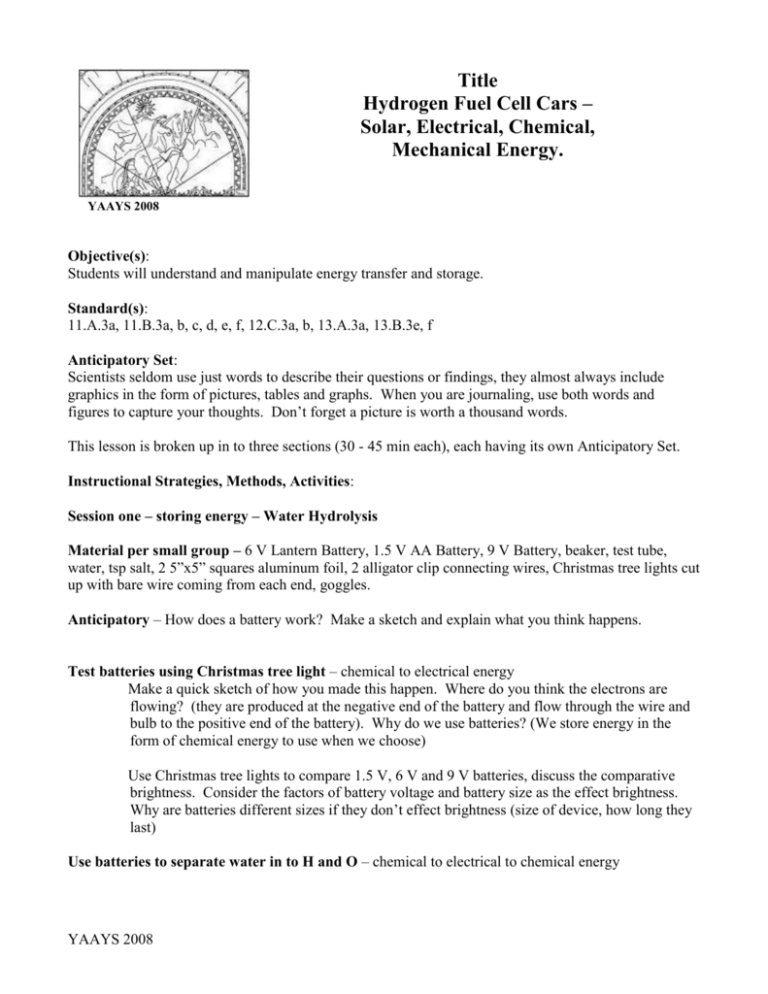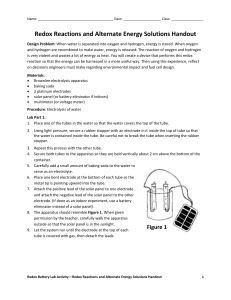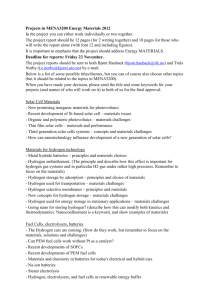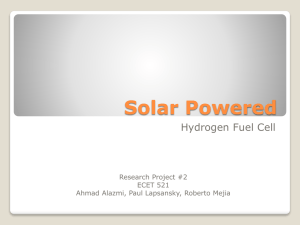Build Hydrogen Fuel Cell Cars
advertisement

Title Hydrogen Fuel Cell Cars – Solar, Electrical, Chemical, Mechanical Energy. YAAYS 2008 Objective(s): Students will understand and manipulate energy transfer and storage. Standard(s): 11.A.3a, 11.B.3a, b, c, d, e, f, 12.C.3a, b, 13.A.3a, 13.B.3e, f Anticipatory Set: Scientists seldom use just words to describe their questions or findings, they almost always include graphics in the form of pictures, tables and graphs. When you are journaling, use both words and figures to capture your thoughts. Don’t forget a picture is worth a thousand words. This lesson is broken up in to three sections (30 - 45 min each), each having its own Anticipatory Set. Instructional Strategies, Methods, Activities: Session one – storing energy – Water Hydrolysis Material per small group – 6 V Lantern Battery, 1.5 V AA Battery, 9 V Battery, beaker, test tube, water, tsp salt, 2 5”x5” squares aluminum foil, 2 alligator clip connecting wires, Christmas tree lights cut up with bare wire coming from each end, goggles. Anticipatory – How does a battery work? Make a sketch and explain what you think happens. Test batteries using Christmas tree light – chemical to electrical energy Make a quick sketch of how you made this happen. Where do you think the electrons are flowing? (they are produced at the negative end of the battery and flow through the wire and bulb to the positive end of the battery). Why do we use batteries? (We store energy in the form of chemical energy to use when we choose) Use Christmas tree lights to compare 1.5 V, 6 V and 9 V batteries, discuss the comparative brightness. Consider the factors of battery voltage and battery size as the effect brightness. Why are batteries different sizes if they don’t effect brightness (size of device, how long they last) Use batteries to separate water in to H and O – chemical to electrical to chemical energy YAAYS 2008 Write the chemical formula for water in your journals,….. if you’re not sure ask someone in your group,...if they’re not sure ask someone in another group,...if they’re not sure ask your teachers. Is water very reactive? What would happen if we held a match to water? If we could split one molecule of water into it’s parts, what would we end up with? If we could split this whole beaker of water into hydrogen and oxygen, what will we end up with more of? What would happen if we could collect the hydrogen and save it for later? What would happen if we held a match to the hydrogen? o o o o o o o o o o o o Fill beaker with water Fold aluminum foil in to electrodes measuring approx ¼” x 5” Scrunch one end of electrode to make a point Fold the pointed end up so that electrode looks like a fish hook Place electrodes into water on opposite sides of beaker with hooks toward center Fold top end of electrode over rim of beaker to keep in place. Do you see anything happening? What’s missing? Attach one end of one alligator clip connector to one terminal of the 6 V battery and the other end to one of the aluminum electrodes. Repeat with the second alligator clips, the second terminal and the second electrode. Do you see anything happening? Which electrode (- or +) producing more bubbles? Is this Hydrogen or Oxygen? Sketch your system, make sure you include + and – terminals and Hydrogen and Oxygen electrodes. Add salt to speed reaction Fill test tube with salt water, invert test tube with thumb over opening, put thumb and test tube into beaker below water level, release thumb, test tube should be filled with water (no bubbles) Maneuver test tube over hydrogen electrode (more bubbles), place open end of test tube down onto electrode hook, carefully lean against opposite side of beaker to collect hydrogen After collecting approx 1” of hydrogen (for more hydrogen, set system aside as class moves on to car activities), remove test tube from beaker and hold horizontally, immediately hold a match to the end of the test tube, there should be an audible “poof”. Session two - converting and storing energy – Using Hydrogen Fuel Cell cars Materials – Hydrogen Fuel Cell car, distilled water, syringe, sunshine or incandescent bulb Anticipatory – Open box with Hydrogen Fuel Cell cars and components. Sketch the major parts of the hydrogen fuel cell car; solar panel, fuel cell, fuel tank, motor/wheels (make it as pretty or as plain as you would like). Explain what you think these different parts do. Name all the ways we can “power” this car (make it move)? Powering the Car o Hang the front end of the car off the table towards you o Use the 1.5 V battery to power the car, flip the battery over. Add information to your sketch showing which wire must be attached to the positive end of the battery to make the care run forward. YAAYS 2008 o Attach the solar cell to the car. o Connect the solar cell wires to the motor wires using metal strips paying attention to the positive and negative connections. o Expose the solar cell to sunlight or bright incandescent bulb to power your car. Add information to your sketch showing the configuration of wiring that powers you car forward. Consider any limitations that you need to consider when using the solar cell (angle of solar cell, shade, peoples shadows, clouds, night). Describe the types of energy you are manipulating (solar to electrical to mechanical) o Attach the fuel cell to the car. o Fill the container at the back of the car with distilled water, use syringe to pull water through the fuel cell (see car instructions) o Connect the fuel cell to the solar cell using the metal strips, make sure you disconnect the motor wires so the motor does not draw energy. o Expose the solar cell to sunlight or bright incandescent bulb to provide energy to split the water into hyrdrogen and oxygen. Add information to your sketch showing your configuration. Note the size of the hyrdrogen tank vs. the oxygen tank. Describe the types of energy you are manipulating (solar to electrical to chemical) o Remove your car from the light source o Rearrange your wires so that the fuel cell is powering your car. Add information to your sketch showing your configuration. Does the motor turn faster from solar power or from fuel cell power? Describe the types of energy you are manipulating (chemical to electrical to mechanical) Session 3 – The Race Anticipatory – What methods did you use to power your car? What were the advantages and disadvantages of each? Materials – Hydrogen Fuel Cell car, distilled water, syringe, sunshine or incandescent bulb Racing the car o Prepare the Hydrogen Fuel Cell car for the race taking into considerations the obstacle you may need to over come (sun angle, shade) o Run the car along a set race course, competing for fastest speed in a set distance and longest distance o Make note of cars winning each category and why each car won the category. o Describe the types of energy you manipulated during the race (solar to electrical to mechanical, solar to electrical to chemical, chemical to electrical to mechanical) all of which originated in the form of solar energy. o Design your own alternative fuel car. Use words and pictures. Be as creative as you’d like! YAAYS 2008







